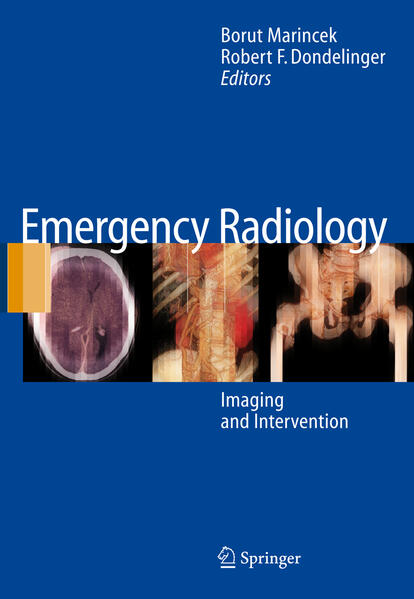This richly illustrated book offers a comprehensive review on the last development in the management and the treatment of acute and life-threatening conditions. It will serve as unique source of information for radiologists and other specialists.
Why write a book on emergency radiology? In many coun- decline. There is an increasing trend towards the use of tries, hospital emergency departments have become a MDCT to evaluate traumatic injuries and non-traumatic major part of the healthcare safety net. In the last decade emergencies. The use of workstations for reporting and for economically-driven structural changes in health care further image reconstruction becomes standard practice. delivery have caused a dramatic increase in emergency On the occasion of the European Congress of Radiology department visits. In response to capacity and staffing (ECR) 2003 and 2004 a Categorical Course on "Emergency pressures, hospitals are developing and implementing a Radiology"has been organized to assess current devel- variety of strategies designed to improve patient flow and ments and concepts in this rapidly growing field. reduce overcrowding in the emergency department. Numerous radiologists, all outstanding and international- Several factors are considered critical for success, such as ly renowned experts in their field, have made superb c- having the right multidisciplinary teams in place and opti- tributions in an ECR syllabus. These authors have now mizing the use of imaging tests. For a critical care physi- made a second effort and updated their contributions for cian it is paramount to obtain the images quickly and for this book. The chapters in the book mirror the topics p- them to be interpreted accurately. sented in the ECR course, encompassing imaging ap- To accomplish this, the emergency radiology division proaches as well as interventional aspects.
Inhaltsverzeichnis
Emergency Radiology: Role of Imaging. - Role of Imaging in the Management of Trauma Victims. - Role of 3D Imaging in the Emergency Room. - Traumatic Injuries: Imaging and Intervention. - Hemostatic Arterial Embolization in Trauma Victims at Admission. - Imaging and Intervention in Post-traumatic Complications (Delayed Intervention). - Imaging of Head Injuries. - Imaging of Facial Injuries. - Imaging of Spinal Injuries. - Imaging of Thoracic Injuries. - Vascular Injuries of the Thorax: Multi-Detector-Row CT and 3D Imaging. - Imaging of Abdominal and Pelvic Injuries. - Imaging and Intervention of Large Arterial Trauma. - Pelvic Fractures. - Traumatic Injuries: Imaging of Peripheral Muskuloskeletal Injuries. - Non-Traumatic Neurologic Emergencies: Imaging and Intervention. - Imaging of Cerebral Ischemia. - Neuroradiological Emergency Interventions. - Non-Traumatic Thoracic Emergencies: Imaging and Intervention. - Acute Chest Pain: Diagnostic Strategies. - CT Diagnosis of Acute Pulmonary Embolism. - CT Venography in an Integrated Diagnostic Strategy of Acute Pulmonary Embolism and Venous Thrombosis. - Imaging and Treatment of Thoracic Fluid and Gas Collections. - Non-Traumatic Abdominal Emergencies: Imaging and Intervention. - Acute Abdominal Pain: Diagnostic Strategies. - Imaging of Acute Intestinal Obstruction. - Imaging and Intervention in Gastrointestinal Hemorrhage and Ischemia. - Imaging and Intervention in Sepsis. - Non-traumatic Abdominal Emergencies: Imaging and Intervention in Acute Biliary Conditions. - Imaging and Intervention in Acute Pancreatic Conditions. - Non-traumatic Uroradiological Emergencies. - Non-Traumatic Vascular Emergencies: Imaging and Intervention. - Imaging and Intervention in Acute Non-traumatic Arterial Condition. - Imaging and Intervention in Acute Venous Occlusion. - Management of Occluded Hemodialysis Shunts, Grafts, and Venous Access. - Imaging Pediatric Emergencies. - Pediatric Neurological Emergencies. - Thoracic Emergencies. - Pediatric Emergencies: Non-traumatic Abdominal Emergencies.














